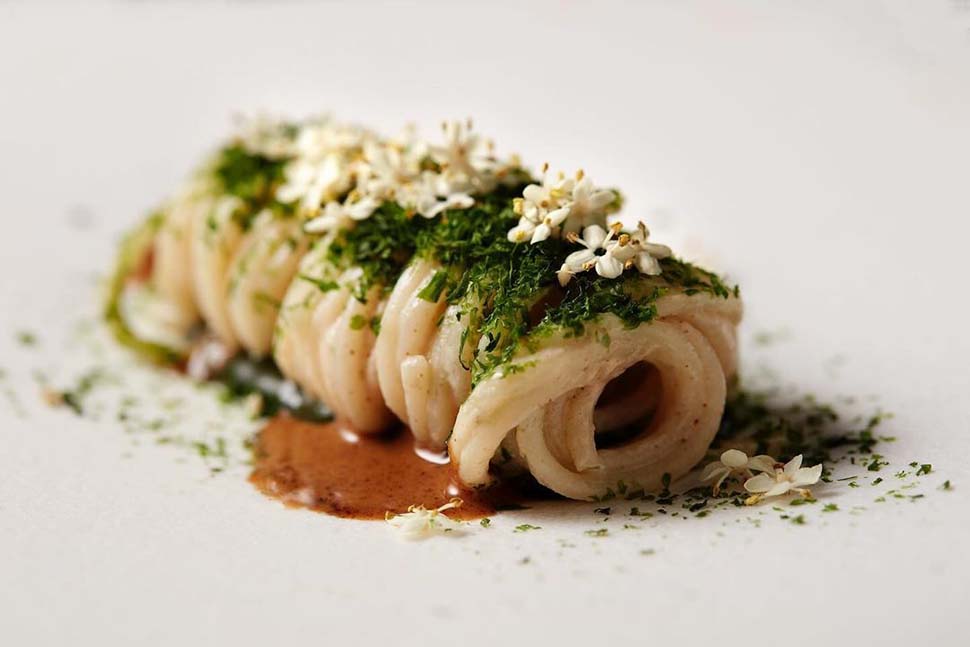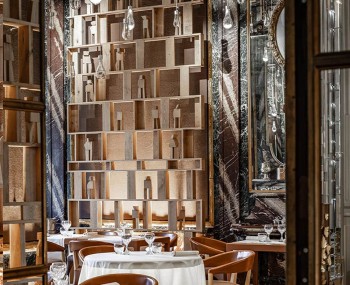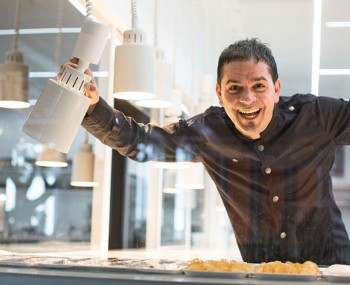Aurora Storari tells her story: the pastry chef of Hémicycle, a Michelin star originally from Rome, recently opened Aura, dessert dining, an intimate dimension that reflects her wandering soul. The sweet here is enhanced through unusual pairings: bite after bite, one arrives in an eclectic universe, with surprising landscapes; the components, varied and ennobled, coexist thanks to ingenuity.
The interview
Aurora Storari, class of 1992, originally from the Eternal City, easily captivates anyone in front of her with her feisty spirit. A versatile, face of haute gastronomy, first and foremost chef, as well as master of the art of confectionery at Hémicycle (1 Michelin star, where she works alongside chef and partner Flavio Lucarini), she opened Aura last July, a neutral place, where two seemingly distant worlds meet and merge: one needs the other, so much so that if circumscribed they would not be able to survive in such a scenario.
Aura is not just dessert, but a real journey, how would you describe its heart and essence? How did the idea come about?
I felt inside the need to express myself at 360 degrees, so the idea had been floating in my head for quite a while. I was born, professionally speaking, in the kitchen; of course, I have also attended a variety of pastry courses, but I did not dwell exclusively on that area, I simply learned the basics, for the rest I consider myself self-taught. Nevertheless, I always felt that I did not want to give up cooking completely, moreover I felt that I could not do without it, it ran through my veins. Once I arrived in Paris I did not know where to place myself, the square oscillated between sacred monsters and a very strict classicism.

During my experience at Le Clarence , I began to put the pieces together, to ask myself questions, amidst the rich scent of freshly baked butter croissants and the buzz of everyday life in the Ville Lumière. It was as if in that din I could distinguish voices, which warmly invited me to find my way. Each whisper inspired me to pursue my kaleidoscopic dreams. I promised myself that I would no longer let certain patterns influence my choices, plus I definitely stopped comparing myself to others. I finally decided to invest in myself and my abilities, focusing on what I could really give to others. This concrete vision reflects my philosophy and my personal space within Hémicycle.
Do you think there is anyone who inspired you more during the training?
The person who most literally opened my mind was my teacher Gianluca Fusto, I was just 20 years old when one day he showed up in the classroom and had us prepare a dish of oysters and chocolate. I was speechless, I had thought for a lifetime about shortcrust pastry and tartlets. He brightened my perspective, passing on to me a fundamental principle for growing in this niche branch: desserts can be made with any ingredient, the important thing is to keep track of the technique.

Looking around then I realized that there are some extraordinary places, like René Frank's Coda in Berlin in which the tasting menu is designed entirely by a pastry chef, and it works! At the time I did not have the means to develop it, today after practicing in some fine dining, and being the right-hand man of my partner, Flavio Lucarini, in our starred restaurant, I confirm that you can experiment and be successful at the same time!
What is your philosophy?
Although I did not invent the concept, I can confidently say that the way I conceive and analyze every aspect of a course is mine alone. Free: this is how I would identify the proposal, a hybrid dictated by what my palate and reason advise me. I do not operate to provoke or impose, rather I improvise, without pandering to predefined patterns, we can say I freestyle, I go with the flow spontaneously, as in rap, leaving room for creativity, pondering it. I do not take cues from colleagues, everyone has a different cultural background, I am 'brutal ' in execution, I start from taste, from what I have in my hands at that moment; this means that I bring out the cook in me, pastry becomes the medium with which I produce.
What kind of clientele do you attract? Curious adventurers or specialists looking for novelty? And how do they usually react to tasting?
The clientele is mixed, there are the regulars, lovers of fine dining, fans of the end of the meal, and those who come to be pleasantly amazed and destabilized; many, in fact, imagine they are tasting sugary delicacies, then as they go along they realize what awaits them.

First, they peer over the counter at me, they have the opportunity to observe me live, as I explain each step to them until the final result is achieved. In addition, they talk to each other and compare. This strategy is new for me as well, at first I had to familiarize myself with a whole new approach, being the center of attention is not easy.
Which dish best represents you? And how do you choose the raw material?

The first course is a must, irreverent, it amuses me a lot, especially when I serve it to locals, for them it is out of context, indeed 'bizarre'. In this case I need the typical texture of semolina pasta, a supporting element, a blank canvas to complete, as pasta sheet or choux can be. Then I go to cream it with a ganache and accompany it with ice cream as if it were a sauce. As far as the raw material is concerned, it is very simple, I choose what is in season, I am precisely implementing a third change in view of the upcoming autumn.

Another noteworthy treat is a parfait, iced mousse, with squid ink, white chocolate, anchovy garum as an alternative to salt, and barbecue-cooked coconut. Diners will feel as if they are eating fish, a roasted cuttlefish to be exact, which is not there in the actual; the color and texture fool the senses and leave them in disbelief.

Or the artichoke alla giudia presented in the form of a cornetto, coated in caramel, in the heart mole of plums, crusco bell pepper and on the surface quenelles of smoked whiskey ice cream. Dishes fluid and immediate in understanding, unpublished dishes that most characterize me, to be enjoyed with eyes closed.
Do you think Paris is well suited to host the format?
I actually think that there is not one city more suited to the initiative than another. I certainly tried hard to introduce myself among the great picturesque maisons and les palais, with their facades adorned with artistic decorations, columns and balconies. I took a risk by going against the grain, I did not open a boulangerie or a boutique offering only scenic single-portions. I chose a coherent message to spread that coincided with the work. If one has a good intuition they can hone it anywhere, London, Berlin, Barcelona.
How would you define Aura's service?

I would describe it as not framed, neither formal nor informal, but unique, totally open, I run the complex, while the room supports me. It is a gourmet, which saw the light of day after months and months of rehearsals, the paper was sketched entirely by hand by a boy from Rome, with food colors, which then find their way to the table, the tableware comes from an artisan who works with glass, the cutlery is from Hermes, vintage. Multiple stages of reflection have brought us this far. The standards and details remain quite high, after all, my corner is set in a prestigious setting.
How important is beverage?
Very much. This is taken care of by Martina, the assistant sommelier at Hémicycle. We do not have a wine list divided by region, but rather an atypical catalog of beverages, dismembered into categories.

After presenting guests with the welcome cocktail, it is our care to suggest to them what to drink with respect to their perceptual preferences, sour, bitter, savory. Juices are made by us, such as with what we find fresh, as are fermentations; we recommend non-alcoholic, coffee, herbaceous in winter, roasted in summer.
What expectations do you have for the future and what would you say to the generation that is specializing in the field?
Significant changes are taking place, albeit slowly, the turnaround is obvious. Now it is not form, aesthetics, but flavor that is crucial. It is essential to question, to get curious: what would happen if I used burnt almond flour instead of traditional almond flour in a recipe? Researching then is imperative, the right product must be identified according to the time of year, you cannot see red fruits in December.

However, I hope to be a reference point for those who are newcomers, you should not be afraid to speak your mind, to take responsibility. It's normal not to please everyone, don't seek approval, don't try to copy those who have arrived, become competent in your style by stepping out of your comfort zone, even if you don't feel understood at first, I've been there. Being good does not mean being conforming, but being authentic and determined to improve yourself.











